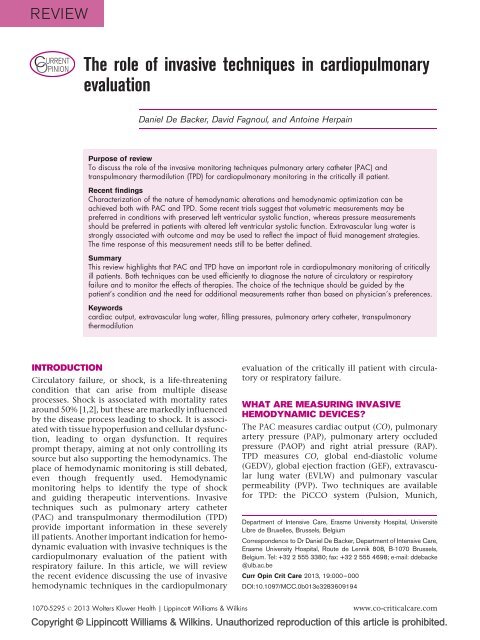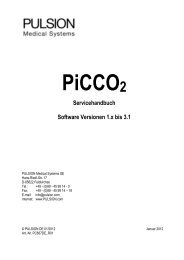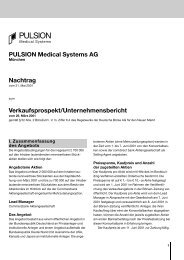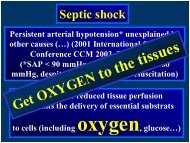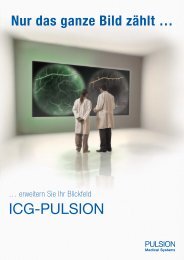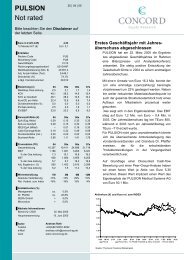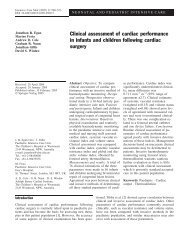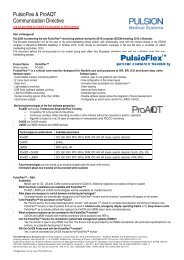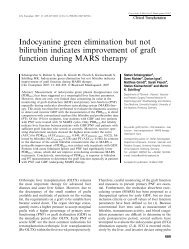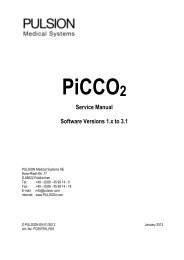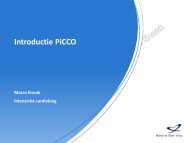The role of invasive techniques in cardiopulmonary evaluation
The role of invasive techniques in cardiopulmonary evaluation
The role of invasive techniques in cardiopulmonary evaluation
Create successful ePaper yourself
Turn your PDF publications into a flip-book with our unique Google optimized e-Paper software.
REVIEW<br />
C URRENT<br />
OPINION<br />
<strong>The</strong> <strong>role</strong> <strong>of</strong> <strong><strong>in</strong>vasive</strong> <strong>techniques</strong> <strong>in</strong> <strong>cardiopulmonary</strong><br />
<strong>evaluation</strong><br />
Daniel De Backer, David Fagnoul, and Anto<strong>in</strong>e Herpa<strong>in</strong><br />
Purpose <strong>of</strong> review<br />
To discuss the <strong>role</strong> <strong>of</strong> the <strong><strong>in</strong>vasive</strong> monitor<strong>in</strong>g <strong>techniques</strong> pulmonary artery catheter (PAC) and<br />
transpulmonary thermodilution (TPD) for <strong>cardiopulmonary</strong> monitor<strong>in</strong>g <strong>in</strong> the critically ill patient.<br />
Recent f<strong>in</strong>d<strong>in</strong>gs<br />
Characterization <strong>of</strong> the nature <strong>of</strong> hemodynamic alterations and hemodynamic optimization can be<br />
achieved both with PAC and TPD. Some recent trials suggest that volumetric measurements may be<br />
preferred <strong>in</strong> conditions with preserved left ventricular systolic function, whereas pressure measurements<br />
should be preferred <strong>in</strong> patients with altered left ventricular systolic function. Extravascular lung water is<br />
strongly associated with outcome and may be used to reflect the impact <strong>of</strong> fluid management strategies.<br />
<strong>The</strong> time response <strong>of</strong> this measurement needs still to be better def<strong>in</strong>ed.<br />
Summary<br />
This review highlights that PAC and TPD have an important <strong>role</strong> <strong>in</strong> <strong>cardiopulmonary</strong> monitor<strong>in</strong>g <strong>of</strong> critically<br />
ill patients. Both <strong>techniques</strong> can be used efficiently to diagnose the nature <strong>of</strong> circulatory or respiratory<br />
failure and to monitor the effects <strong>of</strong> therapies. <strong>The</strong> choice <strong>of</strong> the technique should be guided by the<br />
patient’s condition and the need for additional measurements rather than based on physician’s preferences.<br />
Keywords<br />
cardiac output, extravascular lung water, fill<strong>in</strong>g pressures, pulmonary artery catheter, transpulmonary<br />
thermodilution<br />
INTRODUCTION<br />
Circulatory failure, or shock, is a life-threaten<strong>in</strong>g<br />
condition that can arise from multiple disease<br />
processes. Shock is associated with mortality rates<br />
around 50% [1,2], but these are markedly <strong>in</strong>fluenced<br />
by the disease process lead<strong>in</strong>g to shock. It is associated<br />
with tissue hypoperfusion and cellular dysfunction,<br />
lead<strong>in</strong>g to organ dysfunction. It requires<br />
prompt therapy, aim<strong>in</strong>g at not only controll<strong>in</strong>g its<br />
source but also support<strong>in</strong>g the hemodynamics. <strong>The</strong><br />
place <strong>of</strong> hemodynamic monitor<strong>in</strong>g is still debated,<br />
even though frequently used. Hemodynamic<br />
monitor<strong>in</strong>g helps to identify the type <strong>of</strong> shock<br />
and guid<strong>in</strong>g therapeutic <strong>in</strong>terventions. Invasive<br />
<strong>techniques</strong> such as pulmonary artery catheter<br />
(PAC) and transpulmonary thermodilution (TPD)<br />
provide important <strong>in</strong>formation <strong>in</strong> these severely<br />
ill patients. Another important <strong>in</strong>dication for hemodynamic<br />
<strong>evaluation</strong> with <strong><strong>in</strong>vasive</strong> <strong>techniques</strong> is the<br />
<strong>cardiopulmonary</strong> <strong>evaluation</strong> <strong>of</strong> the patient with<br />
respiratory failure. In this article, we will review<br />
the recent evidence discuss<strong>in</strong>g the use <strong>of</strong> <strong><strong>in</strong>vasive</strong><br />
hemodynamic <strong>techniques</strong> <strong>in</strong> the <strong>cardiopulmonary</strong><br />
<strong>evaluation</strong> <strong>of</strong> the critically ill patient with circulatory<br />
or respiratory failure.<br />
WHAT ARE MEASURING INVASIVE<br />
HEMODYNAMIC DEVICES?<br />
<strong>The</strong> PAC measures cardiac output (CO), pulmonary<br />
artery pressure (PAP), pulmonary artery occluded<br />
pressure (PAOP) and right atrial pressure (RAP).<br />
TPD measures CO, global end-diastolic volume<br />
(GEDV), global ejection fraction (GEF), extravascular<br />
lung water (EVLW) and pulmonary vascular<br />
permeability (PVP). Two <strong>techniques</strong> are available<br />
for TPD: the PiCCO system (Pulsion, Munich,<br />
Department <strong>of</strong> Intensive Care, Erasme University Hospital, Université<br />
Libre de Bruxelles, Brussels, Belgium<br />
Correspondence to Dr Daniel De Backer, Department <strong>of</strong> Intensive Care,<br />
Erasme University Hospital, Route de Lennik 808, B-1070 Brussels,<br />
Belgium. Tel: +32 2 555 3380; fax: +32 2 555 4698; e-mail: ddebacke<br />
@ulb.ac.be<br />
Curr Op<strong>in</strong> Crit Care 2013, 19:000–000<br />
DOI:10.1097/MCC.0b013e3283609194<br />
1070-5295 ß 2013 Wolters Kluwer Health | Lipp<strong>in</strong>cott Williams & Wilk<strong>in</strong>s www.co-criticalcare.com<br />
Copyright © Lipp<strong>in</strong>cott Williams & Wilk<strong>in</strong>s. Unauthorized reproduction <strong>of</strong> this article is prohibited.
Cardiopulmonary monitor<strong>in</strong>g<br />
KEY POINTS<br />
Pulmonary artery catheter and transpulmonary<br />
thermodilution are useful to diagnose the type <strong>of</strong><br />
circulatory or respiratory failure and can help to<br />
monitor the effects <strong>of</strong> therapies.<br />
In patients with altered ejection fraction, <strong>in</strong>travascular<br />
pressures better reflect preload than volumes.<br />
In patients with normal ejection fraction, <strong>in</strong>travascular<br />
volumes better reflect preload than pressures.<br />
Extravascular lung water and permeability <strong>in</strong>dex are<br />
<strong>in</strong>dependently associated with the outcome.<br />
Germany) and the EV1000 (Edwards Lifesciences,<br />
Irv<strong>in</strong>e, California, USA). <strong>The</strong> formulas used by<br />
the two devices to compute CO are quite similar,<br />
but markedly differ for the computation <strong>of</strong> derived<br />
variables.<br />
Measurements <strong>of</strong> CO by thermodilution and by<br />
the PiCCO system have been validated for a long<br />
time. In the pediatric sett<strong>in</strong>g, fewer data are available.<br />
In a pediatric model <strong>of</strong> hemorrhagic shock,<br />
PAC and TPD similarly tracked the changes <strong>in</strong> CO<br />
dur<strong>in</strong>g bleed<strong>in</strong>g and resuscitation [3]. In adults also,<br />
some technical <strong>in</strong>formation, important for rout<strong>in</strong>e<br />
and <strong>in</strong>vestigational use, was published recently. <strong>The</strong><br />
number <strong>of</strong> <strong>in</strong>jections required for calibration and<br />
derived measurements were evaluated <strong>in</strong> 91 hemodynamically<br />
stable patients [4]. At least three <strong>in</strong>jections<br />
should be performed, which allows precision<br />
to drop below 10% for CO as well as GEDV and<br />
EVLW. Hypothermia may affect this reliability, as<br />
signal-to-noise ratio may decrease. In 88 postcardiac<br />
arrest patients, the least significant change for CO,<br />
GEDV, EVLW and PVP were 7.8, 8.5, 7.8 and 12.1%,<br />
respectively, without differences between hypothermic<br />
and nonhypothermic conditions [5]. Two other<br />
trials demonstrated that cont<strong>in</strong>uous renal replacement<br />
therapy does not impact the CO measurements<br />
by TPD [6,7]. F<strong>in</strong>ally, a trial <strong>in</strong> 30 patients<br />
undergo<strong>in</strong>g elective mitral valve repair showed that<br />
mitral regurgitation has m<strong>in</strong>imal impact on the<br />
agreement between the CO obta<strong>in</strong>ed by PAC or by<br />
TPD [8].<br />
<strong>The</strong> EV1000 system has been more recently<br />
<strong>in</strong>troduced. It has been <strong>in</strong>itially validated <strong>in</strong> experimental<br />
conditions [9]. In pigs, GEDV and EVLW<br />
were adequately measured with EV1000 and PiCCO<br />
systems [close correlation (r 2 ¼ 0.79 and 0.97),<br />
m<strong>in</strong>imal bias ( 11 and 5 ml) and limited percentage<br />
errors (14 and 15%)]. Validation <strong>of</strong> the system<br />
was also reported <strong>in</strong> the cl<strong>in</strong>ical sett<strong>in</strong>g. In a prospective,<br />
multicenter, observational study, the two<br />
systems were compared <strong>in</strong> 72 critically ill patients<br />
[10]. Dur<strong>in</strong>g a 72-h observation period, 443 sets<br />
<strong>of</strong> thermodilution measurements were obta<strong>in</strong>ed.<br />
<strong>The</strong>re was an excellent correlation between the<br />
two systems for CO, GEDV and EVLW (r 2 ¼ 0.981,<br />
0.926 and 0.971, respectively) and m<strong>in</strong>imal bias,<br />
result<strong>in</strong>g <strong>in</strong> a low percentage error (9.7, 11.5 and<br />
12.2%). Changes <strong>in</strong> CO, GEDV and EVLW were<br />
tracked with a high concordance between the two<br />
systems. On the basis <strong>of</strong> these two studies, the two<br />
systems seem to perform similarly.<br />
HOW TO DIFFERENTIATE THE TYPE OF<br />
SHOCK?<br />
<strong>The</strong>re are four types <strong>of</strong> shock: hypovolemic, cardiogenic,<br />
obstructive and distributive [11]. Whereas<br />
distributive shock is usually characterized by high<br />
CO and vasodilation, the other types <strong>of</strong> shock are<br />
associated with low CO and vasoconstriction. In<br />
hypovolemic shock, pressures and volumes are<br />
typically low, whereas these are <strong>in</strong>creased <strong>in</strong> cardiogenic<br />
shock. Obstructive shock is associated with<br />
<strong>in</strong>creased PAP and dilated right-sided cavities,<br />
compress<strong>in</strong>g left heart cavities. Tamponade, usually<br />
comprised <strong>in</strong>to cardiogenic shock, is associated with<br />
compression <strong>of</strong> all cavities, and thus elevated pressures<br />
but small volumes.<br />
Diagnosis with PAC is relatively easy (Fig. 1).<br />
Distributive shock is usually characterized by high<br />
CO and mixed-venous O 2 saturation (SvO 2 ), with<br />
fill<strong>in</strong>g pressure <strong>in</strong> the normal to low range. In hypovolemic<br />
shock, CO, SvO 2 and all pressures are<br />
typically low. In cardiogenic shock, CO and SvO 2<br />
are low, whereas PAOP and RAP are high. Obstructive<br />
shock is associated with low CO and SvO 2 , and<br />
<strong>in</strong>creased PAP and RAP, with a RAP which exceeds<br />
PAOP. Tamponade is associated with pulsus paradoxus,<br />
low CO and SvO 2 , together with equally<br />
elevated RAP, PAOP and diastolic PAP.<br />
With TPD, the diagnosis is also easy except for<br />
obstructive shock (Fig. 2). Distributive shock is<br />
usually characterized by high CO and central venous<br />
O 2 saturation (ScvO 2 ), with GEDV <strong>in</strong> the normal to<br />
low range. In hypovolemic shock, CO, ScvO 2 and<br />
GEDV are typically low. In cardiogenic shock, CO<br />
and ScvO 2 are low, whereas GEDV is high. Obstructive<br />
shock is associated with low CO and ScvO 2 , and<br />
<strong>in</strong>creased GEDV. Without echocardiographic assessment,<br />
this shock cannot be dist<strong>in</strong>guished from<br />
cardiogenic shock. Tamponade is associated with<br />
pulsus paradoxus, low CO, low GEDV and ScvO 2 .<br />
<strong>The</strong>re is <strong>of</strong>ten an overlap between these.<br />
Myocardial depression is <strong>of</strong>ten observed <strong>in</strong> distributive<br />
shock, hypovolemia may occur <strong>in</strong> cardiogenic<br />
shock. Accord<strong>in</strong>gly, hemodynamic support <strong>of</strong><br />
2 www.co-criticalcare.com Volume 19 Number 00 Month 2013<br />
Copyright © Lipp<strong>in</strong>cott Williams & Wilk<strong>in</strong>s. Unauthorized reproduction <strong>of</strong> this article is prohibited.
Cardiopulmonary <strong>evaluation</strong> De Backer et al.<br />
Low<br />
Pressures<br />
PAOP/RAP<br />
Hypovolic<br />
PAP normal<br />
RV <strong>in</strong>farction<br />
Cardiac output<br />
and SvO 2<br />
RAP ≥ PAOP<br />
RV failure<br />
PAP<br />
Obstructive<br />
High<br />
Distributive<br />
PAOP = RAP<br />
= PAPd<br />
Tamponade<br />
PAOP > RAP<br />
LV failure<br />
FIGURE 1. Characterization <strong>of</strong> the hemodynamic alterations<br />
<strong>in</strong> patients with circulatory failure us<strong>in</strong>g PAC. This algorithm<br />
allows to identify the different types <strong>of</strong> shock and to<br />
characterize the ma<strong>in</strong> process implicated <strong>in</strong> circulatory<br />
failure. LV, left ventricle; PAC, pulmonary artery catheter;<br />
PAOP, pulmonary artery occluded pressure; PAP, pulmonary<br />
artery pressure; RAP, right atrial pressure; RV, right ventricle.<br />
circulatory shock should not be focused on one<br />
s<strong>in</strong>gle <strong>in</strong>tervention, but rather <strong>in</strong>tervene on the<br />
different alterations. Priority for therapy should be<br />
given to the most relevant alteration.<br />
It is now recognized that echocardiographic<br />
<strong>evaluation</strong> should be used <strong>in</strong> most cases [12]. Nevertheless,<br />
<strong><strong>in</strong>vasive</strong> <strong>techniques</strong> keep their diagnostic<br />
<strong>in</strong>terest, especially when changes might have<br />
GEDV<br />
SVV<br />
Hypovolic<br />
Low<br />
Volumes<br />
Cardiac output<br />
and ScvO 2<br />
GEDV<br />
GEF<br />
LV failure<br />
RV failure<br />
High<br />
Distributive<br />
GEDV +<br />
Pulsus paradoxus<br />
Tamponade<br />
FIGURE 2. Characterization <strong>of</strong> the hemodynamic alterations<br />
<strong>in</strong> patients with circulatory failure us<strong>in</strong>g TPD. This algorithm<br />
allows to identify the different types <strong>of</strong> shock and to<br />
characterize the ma<strong>in</strong> process implicated <strong>in</strong> circulatory<br />
failure. GEDV, global end-diastolic volume; LV, left ventricle;<br />
RV, right ventricle; SVV, stroke volume variation; TPD,<br />
transpulmonary thermodilution.<br />
occurred s<strong>in</strong>ce the <strong>in</strong>itial <strong>evaluation</strong>. It is possible<br />
to categorize the patients <strong>in</strong>to the different shock<br />
categories based either on measurements <strong>of</strong> CO and<br />
pressures with PAC (Fig. 1) or on CO and volumes<br />
with TPD (Fig. 2). This has been recently confirmed<br />
aga<strong>in</strong>st echocardiography. In trauma patients, PAC<br />
adequately identified patients with moderate-tosevere<br />
myocardial dysfunction [13 & ]. In another trial<br />
<strong>in</strong>volv<strong>in</strong>g 29 trauma patients, CO from PAC and<br />
echocardiography were significantly related and<br />
agreed with moderate strength [14].<br />
In order to def<strong>in</strong>e target values <strong>of</strong> volumetric<br />
measurements for therapies, it is important to determ<strong>in</strong>e<br />
the values <strong>of</strong> these variables <strong>in</strong> the target<br />
populations. <strong>The</strong> proposed normal values for GEDV<br />
(680–800 ml/m 2 ) and EVLW (3–7 ml/kg) are based<br />
on measurements <strong>in</strong> critically ill patients without<br />
major hemodynamic or respiratory problems. <strong>The</strong>se<br />
values may fail to represent values observed <strong>in</strong> more<br />
severely ill, but nevertheless hemodynamically<br />
stable, patients. <strong>The</strong> usual values observed <strong>in</strong><br />
high-risk surgical and septic patients were reported<br />
<strong>in</strong> a meta-analysis <strong>in</strong>cluded 64 studies measur<strong>in</strong>g<br />
GEDV and EVLW <strong>in</strong> 1925 patients [15]. GEDV was<br />
higher <strong>in</strong> septic than <strong>in</strong> high-risk surgical patients<br />
[788 (762–816) vs. 694 ml/m 2 (678–711), P < 0.001].<br />
EVLW was also higher <strong>in</strong> septic than <strong>in</strong> surgical<br />
patients [11.0 (9.1–13.0) vs. 7.2 ml/kg (6.9–7.6),<br />
P ¼ 0.001]. <strong>The</strong>se data suggest that different therapeutic<br />
targets should be used <strong>in</strong> high-risk surgical<br />
patients and <strong>in</strong> septic patients.<br />
USE OF INVASIVE HEMODYNAMIC<br />
TECHNIQUES IN GUIDING THERAPY IN<br />
SHOCK<br />
Optimization <strong>of</strong> fluid therapy is a topic <strong>of</strong> <strong>in</strong>tense<br />
research. Cardiac fill<strong>in</strong>g volumes and pressures are<br />
<strong>of</strong>ten used to guide fluid adm<strong>in</strong>istration. <strong>The</strong><br />
relative value <strong>of</strong> cardiac fill<strong>in</strong>g volume and pressures<br />
for predict<strong>in</strong>g fluid responsiveness was evaluated<br />
<strong>in</strong> 32 patients after cardiovascular surgery [16 && ].<br />
Regardless <strong>of</strong> the ejection fraction, basel<strong>in</strong>e CVP<br />
was lower <strong>in</strong> respond<strong>in</strong>g events. PAOP was more<br />
useful than GEDV for predict<strong>in</strong>g fluid responsiveness<br />
when ejection fraction was low, but when<br />
ejection fraction is near normal, GEDV is more<br />
useful than PAOP.<br />
Similar results were observed <strong>in</strong> 40 patients with<br />
complex valvular surgery [17 & ]. Goal-directed<br />
therapy was applied either by PAC or by TPD. <strong>The</strong><br />
TPD group received more fluids, which was associated<br />
with a decrease <strong>in</strong> the duration <strong>of</strong> mechanical<br />
ventilation by 5.2 h compared with the PAC group<br />
(P < 0.05). Unfortunately, the hemodynamic goals<br />
were not identical, as CO was targeted with PAC and<br />
1070-5295 ß 2013 Wolters Kluwer Health | Lipp<strong>in</strong>cott Williams & Wilk<strong>in</strong>s www.co-criticalcare.com 3<br />
Copyright © Lipp<strong>in</strong>cott Williams & Wilk<strong>in</strong>s. Unauthorized reproduction <strong>of</strong> this article is prohibited.
Cardiopulmonary monitor<strong>in</strong>g<br />
oxygen delivery (DO 2 ) with TPD, so that a higher<br />
DO 2 was reached <strong>in</strong> the TPD group.<br />
In patients with severe sepsis, PAC can also be<br />
used for goal-directed therapy. In a before/after<br />
study <strong>in</strong>clud<strong>in</strong>g 2 70 patients, the <strong>in</strong>troduction<br />
<strong>of</strong> a PAC-based protocol was associated with a significantly<br />
higher positive fluid balance <strong>in</strong> comparison<br />
with controls at day 1 (6 vs. 4 l, P < 0.001), but a<br />
lower cumulative fluid balance after 7 days (9 vs.<br />
13 l, P ¼ 0.001), whereas maximum norep<strong>in</strong>ephr<strong>in</strong>e<br />
dose was significantly higher <strong>in</strong> the PAC group [18].<br />
More importantly, PAC-based protocol was associated<br />
with a significant reduction <strong>in</strong> ventilator and<br />
ICU days.<br />
A very important randomized trial evaluated<br />
PAC and TPD for the management <strong>of</strong> 120 critically<br />
ill patients <strong>in</strong> shock, <strong>in</strong>clud<strong>in</strong>g 72 patients with<br />
septic and 48 with nonseptic shock [19 && ]. In both<br />
groups, hemodynamic management was guided by<br />
the algorithms for 72 h after enrollment. In the TPD<br />
group, the upper limits for fluid resuscitation were<br />
EVLW less than 10 ml/kg and GEDV less than<br />
850 ml/m 2 . In the PAC group, a PAOP less than<br />
18–20 mmHg was used. Primary outcomes were<br />
ventilator-free days and length <strong>of</strong> stay <strong>in</strong> the <strong>in</strong>tensive<br />
care unit and the hospital. Overall, ventilatorfree<br />
days, length <strong>of</strong> stay, organ failures and 28-day<br />
mortality were similar <strong>in</strong> both the monitor<strong>in</strong>g<br />
groups. Interest<strong>in</strong>gly, <strong>in</strong> the nonseptic subgroup,<br />
TPD was associated with more days on mechanical<br />
ventilation and longer <strong>in</strong>tensive care unit and hospital<br />
length <strong>of</strong> stay than PAC (P ¼ 0.001). This was<br />
not observed <strong>in</strong> the septic shock subgroup. In both<br />
conditions, TPD (vs. PAC) was associated with a<br />
more positive fluid balance at 24 h. <strong>The</strong> ma<strong>in</strong> conclusion<br />
<strong>of</strong> this trial is that <strong>in</strong>deed globally hemodynamic<br />
management guided by TPD and PAC yield<br />
the same outcomes. <strong>The</strong> improved outcomes by PAC<br />
<strong>in</strong> nonseptic group may be related to the higher<br />
<strong>in</strong>cidence <strong>of</strong> cardiac dysfunction <strong>in</strong> this group.<br />
Indeed, when cardiac function is impaired, pressures<br />
better predict the response to fluids than volumes<br />
[16 && ]. Of course, one cannot rule out that the<br />
resuscitation protocol was not optimal <strong>in</strong> the TPD<br />
group.<br />
<strong>The</strong>se variables may help to guide therapy. In<br />
37 patients submitted to thoracic surgery requir<strong>in</strong>g<br />
one-lung ventilation, a protocol us<strong>in</strong>g a goaldirected<br />
fluid therapy based on stroke volume variation<br />
(SVV) did not <strong>in</strong>crease EVLW [20]. Another<br />
word <strong>of</strong> caution should be mentioned for patients<br />
with severe burn <strong>in</strong>jury. Thirty adult burned<br />
patients (25–60% BSA) received fluid resuscitation<br />
either guided by the PiCCO or were resuscitated<br />
us<strong>in</strong>g Parkland formula associated with traditional<br />
monitor<strong>in</strong>g parameters [21]. Fluid adm<strong>in</strong>istration <strong>in</strong><br />
the <strong>in</strong>itial 72 h after burn <strong>in</strong>jury was significantly<br />
higher <strong>in</strong> the study group. Nevertheless, CO and<br />
derived variables were lower, whereas tissue edema<br />
was worse. This implies that either the resuscitative<br />
algorithm was not optimal or that other factors<br />
other than fluid responsiveness play a <strong>role</strong> <strong>in</strong> these<br />
patients. This study <strong>in</strong>directly emphasizes on the<br />
importance <strong>of</strong> tim<strong>in</strong>g <strong>in</strong> fluid resuscitation [22 && ].<br />
USE OF INVASIVE HEMODYNAMIC<br />
TECHNIQUES IN RESPIRATORY FAILURE<br />
Both PAC and TPD can be used to discrim<strong>in</strong>ate<br />
between hydrostatic and nonhydrostatic causes <strong>of</strong><br />
pulmonary edema. A PAOP greater than 18 mmHg<br />
suggests hydrostatic pulmonary edema. With TPD,<br />
EVLW <strong>of</strong> at least 10 ml/kg <strong>in</strong>dicates edema, but not<br />
the orig<strong>in</strong> <strong>of</strong> the edema. However, the pulmonary<br />
vascular permeability <strong>in</strong>dex, PVP, represent<strong>in</strong>g the<br />
ratio between EVLW and GEDV, is <strong>in</strong>dicative <strong>of</strong> nonhydrostatic<br />
cause when elevated (above 2.5–3.0).<br />
This was nicely illustrated <strong>in</strong> a multi-<strong>in</strong>stitutional,<br />
observational study <strong>in</strong>clud<strong>in</strong>g 266 patients<br />
with a PaO 2 /FiO 2 ratio <strong>of</strong> 300 mmHg or less and<br />
bilateral <strong>in</strong>filtration on chest radiography [23 && ].<br />
Patients were divided <strong>in</strong>to the follow<strong>in</strong>g three<br />
categories <strong>of</strong> respiratory <strong>in</strong>sufficiency: acute lung<br />
<strong>in</strong>jury (ALI)/acute respiratory distress syndrome<br />
(ARDS) (n ¼ 207), cardiogenic edema (n ¼ 26) and<br />
pleural effusion with atelectasis (n ¼ 33). EVLW<br />
was greater <strong>in</strong> ALI/ARDS and cardiogenic edema<br />
patients than <strong>in</strong> those with pleural effusion with<br />
atelectasis (18.5 6.8, 14.4 4.0 and 8.3 2.1,<br />
respectively; P < 0.01). PVP was higher <strong>in</strong> ALI/ARDS<br />
patients than <strong>in</strong> those with cardiogenic edema or<br />
pleural effusion with atelectasis (3.2 1.4, 2.0 0.8,<br />
1.6 0.5; P < 0.01). EVLW correlated with PVP, but<br />
not PaO 2 /FiO 2 . A PVP value <strong>of</strong> 2.6–2.85 diagnosed<br />
ARDS (specificity, 0.90–0.95) and a value less than<br />
1.7 ruled out ARDS (specificity, 0.95). F<strong>in</strong>ally, it<br />
seems that EVLW can be used <strong>in</strong> septic patients to<br />
identify patients at risk to develop ARDS 2–3 days<br />
later [24 & ].<br />
Several trials <strong>in</strong>vestigated the impact <strong>of</strong> fluids on<br />
EVLW. An old study showed that EVLW does not<br />
<strong>in</strong>crease acutely after fluid adm<strong>in</strong>istration [25]. In 17<br />
consecutive postoperative, mechanically ventilated<br />
patients present<strong>in</strong>g with circulatory failure, fluids<br />
were adm<strong>in</strong>istered accord<strong>in</strong>g to SVV measurements<br />
[26]. Dur<strong>in</strong>g the first 12 h after fluid load<strong>in</strong>g, CO<br />
<strong>in</strong>creased but EVLW did not <strong>in</strong>crease. No correlation<br />
was found between the amount <strong>of</strong> fluids adm<strong>in</strong>istered<br />
and the changes <strong>in</strong> EVLW. This implies that<br />
either the protocol used was able to limit the<br />
<strong>in</strong>crease <strong>in</strong> hydrostatic pressures or that EVLW<br />
measurements are not sensitive enough or that a<br />
4 www.co-criticalcare.com Volume 19 Number 00 Month 2013<br />
Copyright © Lipp<strong>in</strong>cott Williams & Wilk<strong>in</strong>s. Unauthorized reproduction <strong>of</strong> this article is prohibited.
Cardiopulmonary <strong>evaluation</strong> De Backer et al.<br />
longer delay should be observed. Another team<br />
found more encourag<strong>in</strong>g results on the dynamic<br />
aspect <strong>of</strong> EVLW [27]. In 62 patients with sepsis, fluid<br />
adm<strong>in</strong>istration resulted <strong>in</strong> an <strong>in</strong>crease <strong>in</strong> EVLW by at<br />
least 10% <strong>in</strong> 27 patients (44%). <strong>The</strong>se patients had<br />
similar hemodynamic variables compared to others,<br />
but were characterized by lower album<strong>in</strong> levels. Of<br />
note, this was not detected by PVP at basel<strong>in</strong>e. In<br />
another trial <strong>in</strong>clud<strong>in</strong>g 63 critically ill patients, an<br />
<strong>in</strong>crease <strong>in</strong> EVLW greater than 10% was observed<br />
<strong>in</strong> patients on the plateau <strong>of</strong> the Starl<strong>in</strong>g relationship<br />
but was not related to basel<strong>in</strong>e PVP, PAOP and<br />
album<strong>in</strong> levels [28 & ].<br />
On the other hand, fluid retrieval does not<br />
rapidly impact EVLW. Even though significant,<br />
changes <strong>in</strong> EVLW dur<strong>in</strong>g fluid retrieval were not<br />
very large. In n<strong>in</strong>e patients with acute renal failure<br />
and hydrostatic or nonhydrostatic pulmonary<br />
edema, GEDV and EVLW m<strong>in</strong>imally decreased after<br />
ultrafiltration <strong>of</strong> 3.6 l [29]. However, this effect may<br />
take time to be detected. In a case–control series,<br />
match<strong>in</strong>g patients receiv<strong>in</strong>g a strategy <strong>of</strong> high PEEP,<br />
album<strong>in</strong> and fluid removal, EVLW decreased more<br />
over 1 week <strong>in</strong> the <strong>in</strong>terventional arm than <strong>in</strong><br />
historical control [30]. This was associated with a<br />
decrease <strong>in</strong> days on mechanical ventilation and <strong>in</strong><br />
ICU length <strong>of</strong> stay. <strong>The</strong>se promis<strong>in</strong>g results were<br />
nevertheless limited by the nature <strong>of</strong> the control<br />
group and should be confirmed <strong>in</strong> prospective<br />
trials.<br />
Several trials evaluated the prognostic value <strong>of</strong><br />
EVLW. In 200 patients with ARDS, the maximum<br />
value <strong>of</strong> EVLW and maximum value <strong>of</strong> PVP were<br />
significantly higher <strong>in</strong> nonsurvivors than <strong>in</strong> survivors<br />
at day 28 [24 10 vs. 19 7 ml/kg, P < 0.001,<br />
and 4.4 (3.3–6.1) vs. 3.5 (2.8–4.4), P ¼ 0.001,<br />
respectively] [31 && ]. <strong>The</strong>se factors rema<strong>in</strong>ed associated<br />
with outcome <strong>in</strong> multivariate analyses, <strong>in</strong><br />
addition to other factors such as positive end-expiratory<br />
pressure level, cumulative fluid balance and<br />
PaO 2 /FiO 2 ratio. This suggests that not only the<br />
consequences (impairment <strong>of</strong> oxygenation), but<br />
also the mechanisms and its severity (endothelial<br />
dysfunction and capillary leak as reflected by permeability<br />
<strong>in</strong>dex) are important for the outcome <strong>in</strong><br />
ARDS. <strong>The</strong>se observations are however limited by<br />
the fact that the worst and mean values were evaluated,<br />
which are affected by the poor evolution <strong>of</strong><br />
the patient. <strong>The</strong> evolution <strong>of</strong> EVLW was evaluated <strong>in</strong><br />
123 critically ill patients, <strong>in</strong> whom achievement <strong>of</strong> a<br />
negative fluid balance was attempted [32]. Decreases<br />
<strong>in</strong> EVLW by more than 2 ml/kg were more frequently<br />
observed <strong>in</strong> patients achiev<strong>in</strong>g a negative<br />
fluid balance. <strong>The</strong>se patients also had more ventilator-free<br />
days dur<strong>in</strong>g the first week. Even though<br />
the nature <strong>of</strong> the trial does not allow to def<strong>in</strong>e a<br />
causal mechanism, these results are <strong>in</strong> l<strong>in</strong>e with the<br />
FACTT (Fluid and Catheter Treatment Trial) that<br />
showed that fluid-restrictive strategy <strong>in</strong> ARDS<br />
patients <strong>in</strong>creased mechanical ventilation-free days<br />
[33].<br />
<strong>The</strong> relationship between EVLW and outcome<br />
was also evaluated <strong>in</strong> 55 patients with septic<br />
shock [34]. At day 1, EVLW and PVP did not differ<br />
between survivors and nonsurvivors. However,<br />
EVLW and PVP decreased <strong>in</strong> the survivors, but<br />
rema<strong>in</strong>ed elevated <strong>in</strong> the nonsurvivors so that<br />
these differed at day 3. EVLW at day 3 rema<strong>in</strong>ed<br />
associated with outcome <strong>in</strong> multiple logistic<br />
regression analysis. <strong>The</strong> authors also nicely showed<br />
that <strong>in</strong>dex<strong>in</strong>g EVLW for actual or predicted body<br />
weight did not affect the results.<br />
CONCLUSION<br />
Both PAC and TPD have an important place <strong>in</strong><br />
<strong>cardiopulmonary</strong> monitor<strong>in</strong>g <strong>of</strong> the critically ill<br />
patient. Both <strong>techniques</strong> can be used efficiently to<br />
diagnose the nature <strong>of</strong> circulatory or respiratory<br />
failure, and to monitor the effects <strong>of</strong> therapies. Each<br />
<strong>of</strong> these <strong>techniques</strong> has limitations, and the choice<br />
<strong>of</strong> the technique should be guided by the patient’s<br />
condition (i.e. pulmonary hypertension, left ventricular<br />
systolic and diastolic function, etc.) and<br />
by the <strong>in</strong>terest <strong>of</strong> specific measurements (such as<br />
EVLW <strong>in</strong> given conditions) rather than based on<br />
unit preferences.<br />
Acknowledgements<br />
None.<br />
Conflicts <strong>of</strong> <strong>in</strong>terest<br />
Daniel De Backer received honoraria for lectures from<br />
Edwards LifeSciences, Pulsion, Gambro Hospal, Eli Lilly,<br />
AM Pharma, Sangart and grant or devices for studies<br />
from Edwards LifeSciences, Pulsion, LiDCO, Vygon,<br />
Cheetah Medical, Imacor, Gambro Hospal, Eli Lilly<br />
and CMA microdialysis.<br />
David Fagnoul and Anto<strong>in</strong>e Herpa<strong>in</strong> have no conflicts <strong>of</strong><br />
<strong>in</strong>terest to declare.<br />
REFERENCES AND RECOMMENDED<br />
READING<br />
Papers <strong>of</strong> particular <strong>in</strong>terest, published with<strong>in</strong> the annual period <strong>of</strong> review, have<br />
been highlighted as:<br />
& <strong>of</strong> special <strong>in</strong>terest<br />
&& <strong>of</strong> outstand<strong>in</strong>g <strong>in</strong>terest<br />
Additional references related to this topic can also be found <strong>in</strong> the Current<br />
World Literature section <strong>in</strong> this issue (pp. 000–000).<br />
1. De Backer D, Biston P, Devriendt J, et al. Comparison <strong>of</strong> dopam<strong>in</strong>e and<br />
norep<strong>in</strong>ephr<strong>in</strong>e <strong>in</strong> the treatment <strong>of</strong> shock. N Engl J Med 2010; 362:779–789.<br />
2. Awad HH, Anderson FA Jr, Gore JM, et al. Cardiogenic shock complicat<strong>in</strong>g<br />
acute coronary syndromes: <strong>in</strong>sights from the Global Registry <strong>of</strong> Acute<br />
Coronary Events. Am Heart J 2012; 163:963–971.<br />
1070-5295 ß 2013 Wolters Kluwer Health | Lipp<strong>in</strong>cott Williams & Wilk<strong>in</strong>s www.co-criticalcare.com 5<br />
Copyright © Lipp<strong>in</strong>cott Williams & Wilk<strong>in</strong>s. Unauthorized reproduction <strong>of</strong> this article is prohibited.
Cardiopulmonary monitor<strong>in</strong>g<br />
3. Ballestero Y, Urbano J, Lopez-Herce J, et al. Pulmonary arterial thermodilution,<br />
femoral arterial thermodilution and bioreactance cardiac output monitor<strong>in</strong>g <strong>in</strong><br />
a pediatric hemorrhagic hypovolemic shock model. Resuscitation 2012;<br />
83:125–129.<br />
4. Monnet X, Persich<strong>in</strong>i R, Ktari M, et al. Precision <strong>of</strong> the transpulmonary<br />
thermodilution measurements. Crit Care 2011; 15:R204.<br />
5. Tagami T, Kushimoto S, Tosa R, et al. <strong>The</strong> precision <strong>of</strong> PiCCO(R) measurements<br />
<strong>in</strong> hypothermic postcardiac arrest patients. Anaesthesia 2012; 67:236–243.<br />
6. Heise D, Faulstich M, Morer O, et al. Influence <strong>of</strong> cont<strong>in</strong>uous renal replacement<br />
therapy on cardiac output measurement us<strong>in</strong>g thermodilution <strong>techniques</strong>.<br />
M<strong>in</strong>erva Anestesiol 2012; 78:315–321.<br />
7. Dufour N, Delville M, Teboul JL, et al. Transpulmonary thermodilution measurements<br />
are not affected by cont<strong>in</strong>uous veno-venous hem<strong>of</strong>iltration at high<br />
blood pump flow. Intensive Care Med 2012; 38:1162–1168.<br />
8. Staier K, Wilhelm M, Wiesenack C, et al. Pulmonary artery vs. transpulmonary<br />
thermodilution for the assessment <strong>of</strong> cardiac output <strong>in</strong> mitral regurgitation: a<br />
prospective observational study. Eur J Anaesthesiol 2012; 29:431–437.<br />
9. Bendjelid K, Giraud R, Siegenthaler N, et al. Validation <strong>of</strong> a new transpulmonary<br />
thermodilution system to assess global end-diastolic volume and<br />
extravascular lung water. Crit Care 2010; 14:R209.<br />
10. Kiefer N, H<strong>of</strong>er CK, Marx G, et al. Cl<strong>in</strong>ical validation <strong>of</strong> a new thermodilution<br />
system for the assessment <strong>of</strong> cardiac output and volumetric parameters. Crit<br />
Care 2012; 16:R98.<br />
11. Weil MH, Shub<strong>in</strong> H. Proposed reclassification <strong>of</strong> shock states with special<br />
reference to distributive defects. Adv Exp Med Biol 1971; 23:13–23.<br />
12. V<strong>in</strong>cent JL, Rhodes A, Perel A, et al. Cl<strong>in</strong>ical review: update on hemodynamic<br />
monitor<strong>in</strong>g – a consensus <strong>of</strong> 16. Crit Care 2011; 15:229.<br />
13.<br />
&<br />
Murthi SB, Hess JR, Hess A, et al. Focused rapid echocardiographic <strong>evaluation</strong><br />
versus vascular catheter-based assessment <strong>of</strong> cardiac output and function <strong>in</strong><br />
critically ill trauma patients. J Trauma Acute Care Surg 2012; 72:1158–1164.<br />
An important study confirm<strong>in</strong>g the <strong>role</strong> <strong>of</strong> a rapid echocardiographic <strong>evaluation</strong>,<br />
focused on the ma<strong>in</strong> hemodynamic features characteriz<strong>in</strong>g the type <strong>of</strong> shock.<br />
14. Tchorz KM, Chandra MS, Markert RJ, et al. Comparison <strong>of</strong> hemodynamic<br />
measurements from <strong><strong>in</strong>vasive</strong> and non<strong><strong>in</strong>vasive</strong> monitor<strong>in</strong>g dur<strong>in</strong>g early resuscitation.<br />
J Trauma Acute Care Surg 2012; 72:852–860.<br />
15. Eichhorn V, Goepfert MS, Eulenburg C, et al. Comparison <strong>of</strong> values <strong>in</strong> critically<br />
ill patients for global end-diastolic volume and extravascular lung water<br />
measured by trans<strong>cardiopulmonary</strong> thermodilution: a meta-analysis <strong>of</strong> the<br />
literature. Med Intensiva 2012; 36:467–474.<br />
16.<br />
&&<br />
Tr<strong>of</strong> RJ, Danad I, Reil<strong>in</strong>gh MW, et al. Cardiac fill<strong>in</strong>g volumes versus pressures<br />
for predict<strong>in</strong>g fluid responsiveness after cardiovascular surgery: the <strong>role</strong> <strong>of</strong><br />
systolic cardiac function. Crit Care 2011; 15:R73.<br />
A very important study. Patients were equipped with PAC and TPD. In patients with<br />
impaired left ventricular function, fill<strong>in</strong>g pressures are more important <strong>in</strong> identify<strong>in</strong>g<br />
nonresponders to fluid challenge, whereas <strong>in</strong> patients with preserved left ventricular<br />
function, GEDV is a better predictor <strong>of</strong> fluid responsiveness than fill<strong>in</strong>g<br />
pressures.<br />
17.<br />
&<br />
Lenk<strong>in</strong> AI, Kirov MY, Kuzkov VV, et al. Comparison <strong>of</strong> goal-directed hemodynamic<br />
optimization us<strong>in</strong>g pulmonary artery catheter and transpulmonary<br />
thermodilution <strong>in</strong> comb<strong>in</strong>ed valve repair: a randomized cl<strong>in</strong>ical trial. Crit Care<br />
Res Pract 2012; 2012:821218.<br />
An <strong>in</strong>terest<strong>in</strong>g, small-sized randomized trial. It is unclear whether the differences<br />
between the groups are related to the devices or to the protocol used (different<br />
targets).<br />
18. Bethlehem C, Groenwold FM, Buter H, et al. <strong>The</strong> impact <strong>of</strong> a pulmonary-arterycatheter-based<br />
protocol on fluid and catecholam<strong>in</strong>e adm<strong>in</strong>istration <strong>in</strong> early<br />
sepsis. Crit Care Res Pract 2012; 2012:161879.<br />
19.<br />
&&<br />
Tr<strong>of</strong> RJ, Beishuizen A, Cornet AD, et al. Volume-limited versus pressurelimited<br />
hemodynamic management <strong>in</strong> septic and nonseptic shock. Crit Care<br />
Med 2012; 40:1177–1185.<br />
An important monocentric trial randomiz<strong>in</strong>g patients with circulatory failure to<br />
volume vs. pressure limited hemodynamic management. No difference <strong>in</strong> the<br />
general population and <strong>in</strong> septic subgroup. In the nonseptic subgroup, PACguided<br />
resuscitation resulted <strong>in</strong> lower days under mechanical ventilation and<br />
shorter ICU length <strong>of</strong> stay than TPD-guided resuscitation.<br />
20. Haas S, Eichhorn V, Hasbach T, et al. Goal-directed fluid therapy us<strong>in</strong>g stroke<br />
volume variation does not result <strong>in</strong> pulmonary fluid overload <strong>in</strong> thoracic surgery<br />
requir<strong>in</strong>g one-lung ventilation. Crit Care Res Pract 2012; 2012:687018.<br />
21. Aboelatta Y, Abdelsalam A. Volume overload <strong>of</strong> fluid resuscitation <strong>in</strong> acutely<br />
burned patients us<strong>in</strong>g transpulmonary thermodilution technique. J Burn Care<br />
Res 2012. [Epub ahead <strong>of</strong> pr<strong>in</strong>t] doi: 10.1097/BCR.0b013e3182642b32<br />
22.<br />
&&<br />
Correa TD, Vuda M, Blaser AR, et al. Effect <strong>of</strong> treatment delay on disease<br />
severity and need for resuscitation <strong>in</strong> porc<strong>in</strong>e fecal peritonitis. Crit Care Med<br />
2012; 40:2841–2849.<br />
A very important experimental trial show<strong>in</strong>g that delayed resuscitation, even<br />
though achiev<strong>in</strong>g the same hemodynamic endpo<strong>in</strong>ts, is associated with higher<br />
activation <strong>of</strong> <strong>in</strong>flammatory mediators and poorer mitochondrial function compared<br />
with rapid resuscitation. This study nicely illustrates the l<strong>in</strong>ks between<br />
hypoxia <strong>in</strong>duced by delayed resuscitation and <strong>in</strong>flammation and mitochondrial<br />
<strong>in</strong>jury <strong>in</strong> sepsis.<br />
23. Kushimoto S, Taira Y, Kitazawa Y, et al. <strong>The</strong> cl<strong>in</strong>ical usefulness <strong>of</strong> extravascular<br />
&& lung water and pulmonary vascular permeability <strong>in</strong>dex to diagnose and<br />
characterize pulmonary edema: a prospective multicenter study on the<br />
quantitative differential diagnostic def<strong>in</strong>ition for acute lung <strong>in</strong>jury/acute respiratory<br />
distress syndrome. Crit Care 2012; 16:R232.<br />
An important study demonstrat<strong>in</strong>g how GEDV, EVLW and PVP can be used to<br />
def<strong>in</strong>e the cause <strong>of</strong> respiratory failure.<br />
24. LeTourneau JL, P<strong>in</strong>ney J, Phillips CR. Extravascular lung water predicts<br />
& progression to acute lung <strong>in</strong>jury <strong>in</strong> patients with <strong>in</strong>creased risk. Crit Care<br />
Med 2012; 40:847–854.<br />
An <strong>in</strong>terest<strong>in</strong>g study show<strong>in</strong>g that the <strong>in</strong>crease <strong>in</strong> EVLW precedes the diagnosis <strong>of</strong><br />
ARDS.<br />
25. Matejovic M, Krouzecky A, Rokyta R Jr, et al. Fluid challenge <strong>in</strong> patients at risk<br />
for fluid load<strong>in</strong>g-<strong>in</strong>duced pulmonary edema. Acta Anaesthesiol Scand 2004;<br />
48:69–73.<br />
26. Ferrando C, Aguilar G, Belda FJ. Extravascular lung water does not <strong>in</strong>crease <strong>in</strong><br />
hypovolemic patients after a fluid-load<strong>in</strong>g protocol guided by the stroke<br />
volume variation. Crit Care Res Pract 2012; 2012:437659.<br />
27. ZhangZ,LuB,NiH,et al. Prediction <strong>of</strong> pulmonary edema by plasma prote<strong>in</strong><br />
levels <strong>in</strong> patients with sepsis. J Crit Care 2012; 27:623–629.<br />
28.<br />
&<br />
Aman J, Groeneveld AB, Nieuw Amerongen GP. Predictors <strong>of</strong> pulmonary<br />
edema formation dur<strong>in</strong>g fluid load<strong>in</strong>g <strong>in</strong> the critically ill with presumed<br />
hypovolemia. Crit Care Med 2012; 40:793–799.<br />
An <strong>in</strong>terest<strong>in</strong>g study dissect<strong>in</strong>g the different factors associated with the development<br />
<strong>of</strong> lung edema after fluid challenge. Unfortunately, some factors can only be<br />
detected dur<strong>in</strong>g fluid adm<strong>in</strong>istration. Accord<strong>in</strong>gly, this study is more useful to<br />
understand the mechanisms than to provide guidel<strong>in</strong>es for bedside optimization <strong>of</strong><br />
fluid challenge.<br />
29. De Laet I, Deeren D, Schoonheydt K, et al. Renal replacement therapy with net<br />
fluid removal lowers <strong>in</strong>tra-abdom<strong>in</strong>al pressure and volumetric <strong>in</strong>dices <strong>in</strong><br />
critically ill patients. Ann Intensive Care 2012; 2 (Suppl. 1):S20.<br />
30. Cordemans C, De Laet I, Van Regenmortel N, et al. Aim<strong>in</strong>g for a negative fluid<br />
balance <strong>in</strong> patients with acute lung <strong>in</strong>jury and <strong>in</strong>creased <strong>in</strong>tra-abdom<strong>in</strong>al<br />
pressure: a pilot study look<strong>in</strong>g at the effects <strong>of</strong> PAL-treatment. Ann Intensive<br />
Care 2012; 2 (Suppl. 1):S15.<br />
31.<br />
&&<br />
Jozwiak M, Silva S, Persich<strong>in</strong>i R, et al. Extravascular lung water is an<br />
<strong>in</strong>dependent prognostic factor <strong>in</strong> patients with acute respiratory distress<br />
syndrome. Crit Care Med 2013; 41:472–480.<br />
An analysis <strong>of</strong> a large database, demonstrat<strong>in</strong>g that EVLW is a factor <strong>in</strong>dependently<br />
associated with outcome.<br />
32. Cordemans C, De Laet I, Van Regenmortel N, et al. Fluid management <strong>in</strong><br />
critically ill patients: the <strong>role</strong> <strong>of</strong> extravascular lung water, abdom<strong>in</strong>al hypertension,<br />
capillary leak, and fluid balance. Ann Intensive Care 2012; 2 (Suppl. 1):<br />
S1.<br />
33. Wiedemann HP, Wheeler AP, Bernard GR, et al. Comparison <strong>of</strong> two fluidmanagement<br />
strategies <strong>in</strong> acute lung <strong>in</strong>jury. N Engl J Med 2006; 354:2564–<br />
2575.<br />
34. Mallat J, Pepy F, Lemyze M, et al. Extravascular lung water <strong>in</strong>dexed or not to<br />
predicted body weight is a predictor <strong>of</strong> mortality <strong>in</strong> septic shock patients. J Crit<br />
Care 2012; 27:376–383.<br />
6 www.co-criticalcare.com Volume 19 Number 00 Month 2013<br />
Copyright © Lipp<strong>in</strong>cott Williams & Wilk<strong>in</strong>s. Unauthorized reproduction <strong>of</strong> this article is prohibited.


